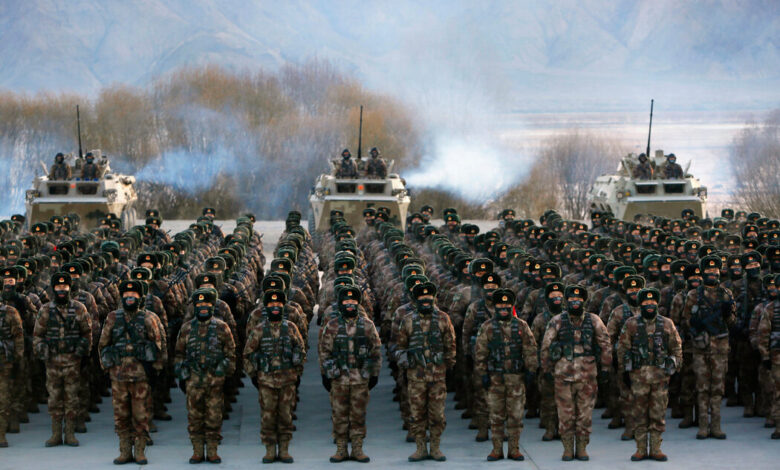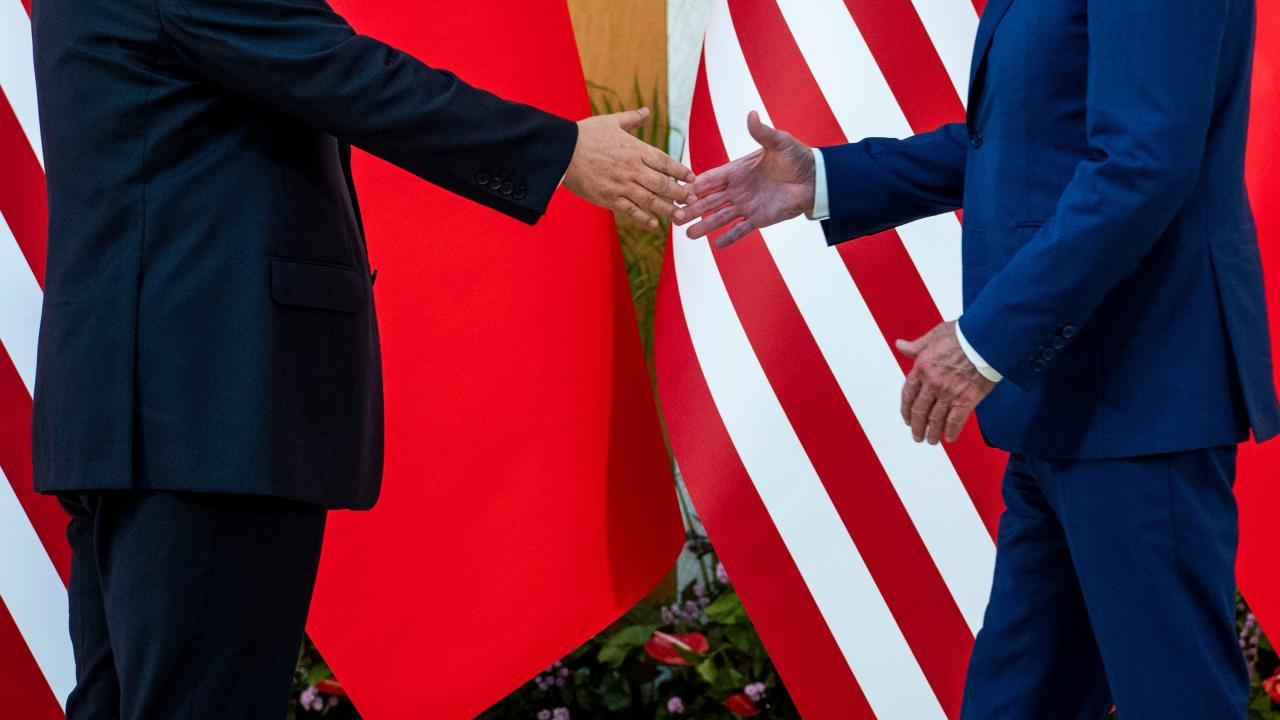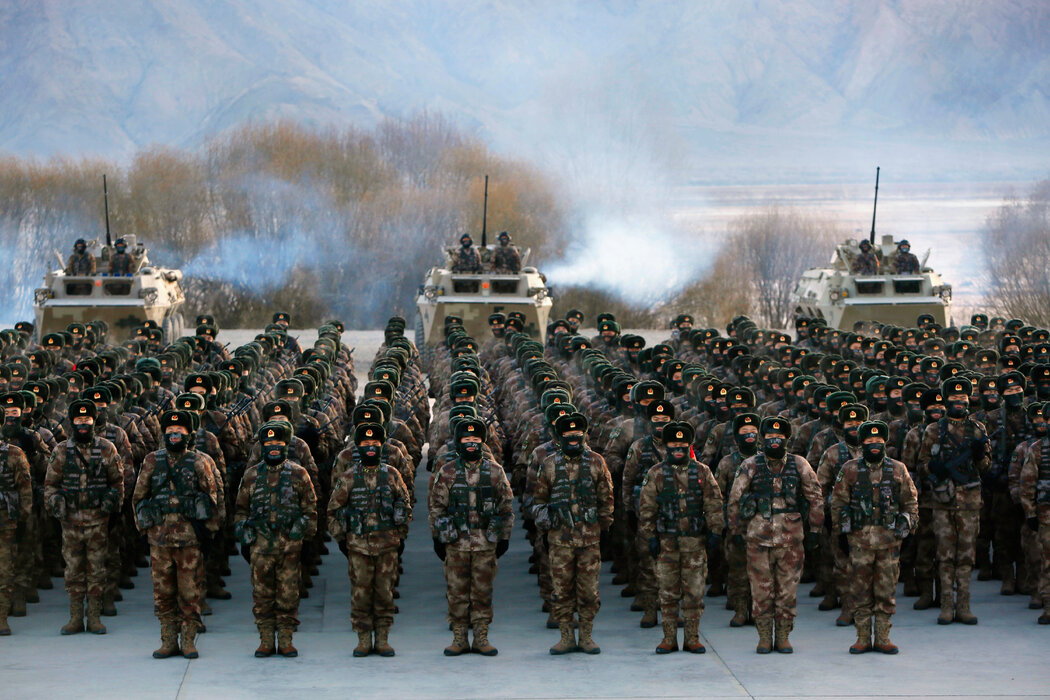
Is America Ready for a War with China?
Is America ready for a war with China? The question hangs heavy in the air, a stark reminder of the complex and evolving relationship between these two global superpowers. The potential for conflict, while not imminent, is a real possibility, fueled by a combination of historical tensions, economic interdependence, and ideological clashes.
As we navigate a world increasingly shaped by these two nations, understanding the potential consequences of a war becomes crucial.
From the historical context of the Cold War to the modern-day trade wars, the US-China relationship has been marked by both cooperation and competition. Their economic interdependence is undeniable, with each nation heavily reliant on the other for trade and investment.
Yet, their political and ideological differences remain significant, creating a volatile mix of potential conflict and uneasy coexistence.
Historical Context
The relationship between the United States and China has been a complex and dynamic one, marked by periods of cooperation and conflict. From early trade relations to the Cold War and beyond, the two nations have engaged in a long-standing interplay of economic, political, and military interests.
Early Interactions and Trade
The US and China first established formal diplomatic relations in 1844, following the First Opium War. Trade played a significant role in their early interactions, with the US importing goods like silk and tea from China. However, this relationship was often strained by unequal treaties and tensions over trade practices.
The Cold War and the Rise of China
During the Cold War, the US and China found themselves on opposite sides of the ideological divide. The US supported the Nationalist government in Taiwan, while China aligned with the Soviet Union. However, the two nations began to engage in limited diplomatic contact in the late 1960s, leading to the establishment of formal diplomatic relations in 1979.
This period witnessed the opening up of China’s economy and its rapid economic growth.
The Evolution of Rivalry
The US-China relationship evolved into a complex rivalry in the late 20th and early 21st centuries. This rivalry encompassed various dimensions:
- Economic Competition:China’s rise as an economic powerhouse has led to intense competition with the US in global markets. The trade deficit between the two nations has been a source of tension, with the US imposing tariffs on Chinese goods and China retaliating with its own tariffs.
- Political and Ideological Differences:The US and China have divergent political systems and ideologies. The US promotes democracy and human rights, while China maintains a communist one-party state. These differences have led to friction on issues such as Taiwan, Hong Kong, and Xinjiang.
- Military Buildup and Strategic Competition:China has been rapidly modernizing its military, expanding its naval capabilities, and asserting its presence in the South China Sea. This has raised concerns in the US about China’s growing military power and its potential to challenge US dominance in the region.
Key Events and Tensions
Several key events have shaped the US-China relationship, highlighting the ongoing tensions and potential for conflict:
- The Taiwan Strait Crisis (1995-1996):China conducted military exercises near Taiwan in response to a visit by US President Bill Clinton to the island. This event raised concerns about the potential for conflict over Taiwan’s status.
- The South China Sea Disputes:China’s claims over the South China Sea have led to disputes with several neighboring countries, including the US. The US has conducted freedom of navigation operations in the region to challenge China’s claims.
- The Trade War (2018-present):The US and China have engaged in a trade war, imposing tariffs on each other’s goods. This has disrupted global trade and led to economic uncertainty.
The Future of US-China Relations
The US-China relationship remains complex and uncertain. The two nations are deeply interconnected economically, but they also have fundamental differences in their political systems and strategic interests. The future of their relationship will depend on their ability to manage these differences and find areas of cooperation.
Economic Interdependence
The United States and China are deeply intertwined economically, forming a complex web of trade, investment, and supply chains. This interdependence has fueled economic growth for both nations but also creates significant vulnerabilities in the event of a conflict.
The Extent of Economic Interdependence
The economic ties between the US and China are extensive and multifaceted.
- Trade:China is the US’s largest trading partner, with bilateral trade exceeding $750 billion in 2022. The US imports a wide range of goods from China, including electronics, machinery, furniture, and clothing, while exporting agricultural products, aircraft, and chemicals.
- Investment:US companies have invested heavily in China, establishing manufacturing facilities and engaging in joint ventures. Conversely, China has invested in US companies and assets, particularly in real estate and financial markets.
- Supply Chains:Global supply chains are deeply integrated with China, with many US companies relying on Chinese manufacturers for components and finished goods. This dependence extends to critical industries like technology, pharmaceuticals, and automobiles.
Impact of War on Global Trade and Supply Chains
A war between the US and China would have devastating consequences for global trade and supply chains.
- Trade Disruptions:Trade between the two countries would likely cease, leading to shortages of essential goods and rising prices globally. The disruption would also impact businesses and consumers in other countries reliant on trade with either the US or China.
- Supply Chain Disruptions:The war would severely disrupt global supply chains, as companies scramble to find alternative sources for components and goods. This would lead to production delays, higher costs, and potentially even shortages of essential products.
- Economic Recession:The economic impact of a war would be severe, potentially leading to a global recession. The disruption to trade and supply chains, coupled with the uncertainty and volatility of the conflict, would damage economic confidence and investment.
Economic Strengths and Vulnerabilities
Both the US and China possess economic strengths and vulnerabilities that would be amplified in the event of a war.
US Economic Strengths and Vulnerabilities
- Strengths:The US has a large and diversified economy, a strong financial system, and a highly skilled workforce. It also has a significant technological advantage in areas like semiconductors and software.
- Vulnerabilities:The US economy is highly reliant on consumer spending, which could be impacted by rising prices and uncertainty. The country also faces a growing national debt and a widening trade deficit.
China Economic Strengths and Vulnerabilities
- Strengths:China has a vast and growing economy, a large and low-cost labor force, and a strong manufacturing sector. It also has significant reserves of foreign currency and a large domestic market.
- Vulnerabilities:China’s economy is heavily reliant on exports, which could be severely impacted by a trade war or other economic sanctions. The country also faces challenges in areas like innovation and environmental sustainability.
Military Capabilities

A direct military confrontation between the United States and China would be a cataclysmic event with potentially devastating consequences for both countries and the world. Understanding the military capabilities of each nation is crucial for assessing the risks and potential outcomes of such a conflict.
US Military Capabilities
The United States possesses the most powerful military in the world, boasting advanced technology, a global presence, and vast resources. The US military is organized into the following branches:
- Army:The US Army is the largest branch of the military, with over 1 million active personnel. It is equipped with sophisticated weaponry, including tanks, armored vehicles, artillery, and advanced helicopters. The Army also has a robust logistical network that allows it to deploy troops and equipment around the world.
- Navy:The US Navy is the largest and most powerful navy in the world, with over 300,000 active personnel. It operates 11 aircraft carriers, nuclear submarines, destroyers, cruisers, and other warships. The Navy also has a vast network of bases and ports around the globe, giving it a significant strategic advantage.
- Air Force:The US Air Force is the world’s most technologically advanced air force, with over 300,000 active personnel. It operates fighter jets, bombers, transport aircraft, and other aircraft, including unmanned aerial vehicles (UAVs). The Air Force has a vast network of air bases and is capable of conducting air strikes and other operations around the world.
The idea of America being ready for a war with China is a complex one, with many factors at play. We’re seeing rising tensions, economic competition, and a global power struggle. But amidst all this, it’s important to remember that the potential consequences of conflict are enormous, especially when considering the global impact of a pandemic like COVID-19.
Recent reports, like the one claiming that COVID-19 vaccines can cause permanent disabilities , highlight the fragility of our health systems and the need for global cooperation. If America and China were to engage in a conflict, it would undoubtedly exacerbate existing global challenges and put the world at risk in ways we can’t fully comprehend.
- Marine Corps:The US Marine Corps is a highly trained and mobile force of over 180,000 active personnel. It is designed for rapid deployment and is capable of conducting amphibious operations and land warfare. The Marines have a strong focus on expeditionary warfare and are often deployed to support US interests abroad.
- Coast Guard:The US Coast Guard is a multi-mission service with over 40,000 active personnel. It is responsible for maritime safety, law enforcement, and national defense. The Coast Guard operates a fleet of cutters, patrol boats, and aircraft.
The US military has a long history of technological innovation and is at the forefront of developing new weapons systems. Examples include:
- Hypersonic missiles:These missiles can travel at speeds exceeding five times the speed of sound, making them difficult to intercept.
- Artificial intelligence (AI):AI is being used to develop autonomous weapons systems and improve the effectiveness of existing weapons.
- Space-based weapons:The US is developing space-based weapons that could be used to disrupt enemy communications and satellites.
The US military has a global network of alliances and partnerships, which provides it with access to resources and bases around the world. This network allows the US to project power and influence in various regions.
Chinese Military Capabilities
China’s military has undergone a dramatic transformation in recent decades, evolving from a largely land-based force to a modern, technologically advanced military with significant capabilities across all domains. The People’s Liberation Army (PLA) is organized into the following branches:
- PLA Ground Force:The PLA Ground Force is the largest branch of the PLA, with over 2 million active personnel. It is equipped with a wide range of weapons, including tanks, armored vehicles, artillery, and missiles. The Ground Force has been modernizing its equipment and focusing on improving its operational capabilities.
- PLA Navy:The PLA Navy is the second-largest navy in the world, with over 300,000 active personnel. It operates aircraft carriers, submarines, destroyers, cruisers, and other warships. The Navy has been rapidly expanding its fleet and is increasingly capable of projecting power beyond its territorial waters.
- PLA Air Force:The PLA Air Force is the world’s largest air force, with over 300,000 active personnel. It operates fighter jets, bombers, transport aircraft, and other aircraft, including UAVs. The Air Force has been modernizing its fleet and developing new technologies, such as stealth aircraft and advanced missiles.
- PLA Rocket Force:The PLA Rocket Force is responsible for China’s strategic nuclear deterrent. It operates a wide range of ballistic missiles, including intercontinental ballistic missiles (ICBMs) capable of reaching the United States.
- PLA Strategic Support Force:This force is responsible for space, cyber, and electronic warfare capabilities. It is developing advanced technologies to support the PLA’s operations.
China’s military modernization has been driven by its desire to secure its territorial interests, protect its economic interests, and project power on the global stage. China has been investing heavily in its military, particularly in developing advanced technologies. Examples include:
- Hypersonic missiles:China has developed hypersonic missiles that can travel at speeds exceeding five times the speed of sound, making them difficult to intercept.
- Anti-satellite weapons:China has tested anti-satellite weapons that could be used to destroy enemy satellites.
- Cyber warfare capabilities:China has developed sophisticated cyber warfare capabilities that could be used to disrupt enemy communications and networks.
China’s military doctrine emphasizes the use of “people’s war,” which involves mobilizing the entire population to support the war effort. This doctrine also emphasizes the use of “asymmetric warfare,” which involves using unconventional tactics and weapons to exploit the weaknesses of a stronger adversary.
Political and Ideological Differences
The United States and China, despite their economic interdependence, stand apart in their political systems and ideologies. These differences are deeply rooted in history and shape their interactions on the global stage, potentially influencing the likelihood of conflict.
Fundamental Differences
The United States operates as a democratic republic with a strong emphasis on individual rights and freedoms. Its political system is characterized by a separation of powers, checks and balances, and a multi-party system. China, on the other hand, is a communist state with a single-party system, where the Chinese Communist Party (CCP) holds absolute power.
The CCP emphasizes national unity, social harmony, and economic development.
Impact on War Likelihood
These fundamental differences can lead to tensions and mistrust. The US prioritizes democratic values and human rights, which it may seek to promote globally, while China prioritizes national sovereignty and economic development. This clash of values can create friction in areas like trade, technology, and security.
For example, the US has imposed sanctions on China over human rights violations in Xinjiang and Hong Kong, while China has criticized the US for its foreign policy in the Middle East and its intervention in domestic affairs.
Role of International Organizations and Alliances
International organizations and alliances play a crucial role in shaping the US-China relationship. The United Nations (UN) provides a platform for dialogue and cooperation, but the two countries often hold opposing views on issues like climate change, nuclear proliferation, and security council reform.
The US has also formed alliances with countries in the Asia-Pacific region, such as Japan, South Korea, and Australia, to counter China’s growing influence. These alliances can create a sense of competition and potentially increase the risk of miscalculation or escalation.
Domestic Considerations: Is America Ready For A War With China

The potential for war between the United States and China is not only a matter of international relations but also a complex issue with significant domestic implications. The political landscape, public opinion, and domestic factors in both countries could significantly influence the decision-making process regarding a potential conflict.
Political Landscape and Pressures
The political landscapes of the United States and China are vastly different, with each nation facing unique pressures and constraints on their respective governments. In the United States, a two-party system with a strong emphasis on individual liberties and democratic principles creates a complex and often contentious political environment.
The United States government is also subject to public scrutiny and pressure from various interest groups. Conversely, China’s political system is characterized by a single-party rule under the Communist Party of China, which has a significant influence on all aspects of governance and societal life.
This centralized structure allows the Chinese government to make decisions with relative speed and efficiency, but it also limits public participation and accountability.
United States
- The US political system is characterized by a two-party system, with the Democratic and Republican parties dominating the political landscape. This system often leads to partisan gridlock, making it difficult to reach consensus on major issues, including foreign policy.
- The US government is subject to significant public scrutiny and pressure from various interest groups, including the media, think tanks, and advocacy organizations. These groups can influence public opinion and exert pressure on policymakers to take certain actions.
- The US military is also subject to congressional oversight and funding, which can create constraints on its ability to act decisively in a crisis.
China
- The Chinese Communist Party (CCP) has a strong grip on power, with its leadership making decisions with relative speed and efficiency. However, this centralized structure also limits public participation and accountability.
- The CCP is highly sensitive to public opinion, particularly regarding issues related to national sovereignty and security.
- China’s military is subject to the CCP’s control and is seen as a tool of national power. The military’s ability to act independently is limited.
Public Opinion
Public opinion in both the United States and China plays a significant role in shaping the political landscape and influencing the decision-making process.
United States
- Public opinion in the United States regarding a potential war with China is divided. Some Americans support a more assertive stance towards China, while others are wary of the risks of conflict.
- Public opinion can be influenced by media coverage, political rhetoric, and events such as trade disputes or military exercises.
- The public’s willingness to support a war effort can also be influenced by factors such as the perceived threat posed by China and the potential costs of conflict.
China
- Public opinion in China regarding a potential war with the United States is generally supportive of the government’s stance. Chinese citizens are often nationalistic and proud of their country’s achievements.
- The Chinese government has a strong influence on public opinion through state-controlled media and propaganda.
- The public’s willingness to support a war effort is likely to be high if it is perceived as necessary to defend China’s national interests.
Domestic Factors, Is america ready for a war with china
Domestic factors, such as economic conditions, social unrest, and political instability, can also influence the decision-making process in both the United States and China.
The prospect of a war with China is a chilling thought, and it’s hard to imagine how America would fare in such a conflict. But while we grapple with the potential for global war, we also need to consider the health risks of our own population.
A recent study suggests a possible link between the Novavax COVID-19 vaccine and heart inflammation. If a significant portion of our population is vulnerable to health complications, how can we even begin to prepare for a war with China?
It’s a complex issue, and one that requires careful consideration from both political and medical experts.
United States
- The US economy is heavily reliant on global trade, and a war with China could have significant economic repercussions.
- The US government may be reluctant to engage in a war that could disrupt the economy or lead to a loss of jobs.
- Social unrest and political polarization could also make it difficult for the US government to mobilize public support for a war effort.
China
- China’s economy is also heavily reliant on global trade, and a war with the United States could have a devastating impact on its economic growth.
- The Chinese government may be reluctant to engage in a war that could threaten its economic stability or lead to social unrest.
- Political instability within China could also make it difficult for the government to maintain control in the event of a war.
Regional Implications
A US-China war would have profound and destabilizing consequences for the Asia-Pacific region, potentially triggering a cascade of events that could reshape the geopolitical landscape for decades to come. The conflict would not only directly affect the two superpowers but also have significant implications for regional stability, security, and economic prosperity.
Impact on Regional Stability and Security
A war between the United States and China would almost certainly lead to a dramatic escalation of tensions in the region. The conflict could spill over into neighboring countries, potentially drawing them into the fighting. The South China Sea, a vital waterway for global trade and a flashpoint of territorial disputes, would likely become a major battleground.
The presence of US and Chinese military forces in the region, coupled with the deployment of advanced weapons systems, would significantly increase the risk of accidental escalation and unintended consequences. The conflict could also lead to a proliferation of arms in the region, as countries seek to bolster their defenses against potential threats.
Role of Other Regional Powers
The conflict would force other regional powers to choose sides, potentially leading to the formation of new alliances and rivalries. Countries like Japan, South Korea, Australia, and India would be under immense pressure to align themselves with either the United States or China.
These decisions would have long-term implications for regional security and stability.
“The strategic calculus of regional powers would be dramatically altered, leading to a scramble for alliances and a reassessment of national security strategies.”
Impact on US-Allies Relations
A war between the United States and China would also strain relations between the United States and its allies in the region. The US would likely rely heavily on its allies for support, including access to military bases and logistical assistance.
However, the conflict could also lead to friction and disagreement over strategy and objectives. Some allies may be reluctant to fully commit to the US war effort, fearing economic repercussions or a backlash from China.
Global Consequences
A US-China war would have catastrophic global consequences, far exceeding the immediate conflict. It would disrupt the global economy, exacerbate humanitarian crises, and raise the specter of nuclear war. The international order and the existing global system would be profoundly impacted, with long-lasting implications for international relations.
Economic Disruptions
The economic interdependence between the US and China is vast and complex. A war would inevitably disrupt global supply chains, leading to shortages of essential goods and commodities. This would trigger inflation and economic recession worldwide.
- The disruption of global trade would lead to soaring prices for energy, food, and other essential commodities, affecting the poorest nations disproportionately.
- The global financial system would be destabilized, with potential for a global financial crisis. The interconnectedness of economies would amplify the impact of economic shocks.
- The world’s major economies would suffer significant losses, impacting global economic growth and development.
Humanitarian Crises
A war between the US and China would likely lead to massive civilian casualties and displacement. The conflict could also spark regional instability and humanitarian crises.
- Millions of people could be forced to flee their homes, leading to refugee crises and exacerbating existing humanitarian challenges.
- The conflict could disrupt access to food, water, and medical supplies, leading to widespread famine and disease.
- The conflict could also escalate tensions in other regions, triggering new conflicts and exacerbating existing humanitarian crises.
Nuclear Risks
The possibility of nuclear escalation in a US-China war is a grave concern. Both countries possess large nuclear arsenals, and any escalation could lead to a nuclear exchange with devastating consequences.
The question of whether America is ready for a war with China is a complex one, with economic factors playing a crucial role. One argument against such a conflict is that it could trigger a financial crisis, as explored in the case for risking default on the debt.
The interconnected nature of the global economy means that a war between the two superpowers could have disastrous consequences for both sides, potentially pushing the world into a recession. The implications for both American and Chinese citizens would be profound, making it a scenario that should be avoided at all costs.
- A nuclear exchange would have catastrophic consequences, leading to widespread death and destruction, long-term environmental damage, and a nuclear winter.
- The risk of nuclear escalation is heightened by the possibility of miscalculation or accidental launch.
- The consequences of a nuclear war would be global, impacting the entire planet.
Impact on Global Order
A US-China war would fundamentally alter the global order, leading to a multipolar world with increased instability and uncertainty.
- The war would undermine the existing international institutions and norms, weakening the framework for global cooperation.
- The conflict could lead to the emergence of new power blocs and alliances, with the potential for increased conflict and instability.
- The war would likely result in a shift in global power dynamics, with new players emerging and the existing order being reshaped.
Future of International Relations
A US-China war would have profound implications for the future of international relations. The conflict could lead to a new era of great power rivalry, with increased competition and conflict.
- The war would likely increase mistrust and suspicion between nations, making it more difficult to achieve international cooperation.
- The conflict could also lead to a resurgence of nationalism and protectionism, further eroding the foundations of global cooperation.
- The war would have a lasting impact on the international system, shaping the future of global politics and security for decades to come.
Alternative Scenarios
A direct military confrontation between the United States and China would have catastrophic consequences for both nations and the world. Therefore, exploring alternative scenarios to a war is crucial. This section examines potential diplomatic solutions, economic sanctions, and other conflict resolution mechanisms to prevent a military clash.
Diplomatic Solutions
Diplomacy remains the most desirable approach to managing the US-China relationship. It involves open communication, mutual understanding, and compromise.
- Strengthening Existing Dialogue Channels:Enhancing existing platforms like the Strategic and Economic Dialogue (SED) and the US-China Joint Commission on Commerce and Trade (JCCT) can facilitate regular communication and address concerns.
- Addressing Specific Issues:Focusing on specific areas of conflict, such as trade disputes, cybersecurity, and the South China Sea, can create opportunities for cooperation and reduce tensions.
- Building Trust and Confidence:Promoting cultural exchanges, people-to-people diplomacy, and joint initiatives in areas like climate change and global health can foster trust and understanding between the two nations.
Economic Sanctions
Economic sanctions are often used as a tool to pressure nations into changing their behavior. However, their effectiveness against China is debatable due to its size and economic interdependence with the US.
- Targeted Sanctions:Imposing sanctions on specific individuals or entities linked to Chinese government policies could be more effective than broad-based sanctions.
- Impact on Global Economy:Sanctions could disrupt global supply chains, increase inflation, and harm economies worldwide, including the US.
- China’s Economic Resilience:China has a large domestic market and is increasingly reliant on its own technology and innovation, making it less vulnerable to economic sanctions.
Other Conflict Resolution Mechanisms
Beyond diplomacy and sanctions, other approaches can help manage the US-China relationship and prevent a war.
- International Cooperation:Strengthening international institutions like the United Nations and working collaboratively on global challenges like climate change can create a more stable environment.
- Non-Proliferation Agreements:Renewing and strengthening non-proliferation treaties, such as the Nuclear Non-Proliferation Treaty (NPT), can help reduce the risk of nuclear war.
- Confidence-Building Measures:Implementing confidence-building measures, such as military exercises and information sharing, can enhance transparency and reduce the likelihood of miscalculations.
Technological Considerations
Technology plays a pivotal role in shaping the potential for a US-China war. Advanced technologies, particularly in the realm of cyberwarfare, artificial intelligence, and other cutting-edge innovations, have the potential to fundamentally alter the nature of conflict, influencing the strategies, tactics, and outcomes of any potential confrontation.
Cyberwarfare
Cyberwarfare has emerged as a critical domain of conflict, potentially impacting the course of a US-China war in various ways.
- Disruption of critical infrastructure: Both countries possess the capability to disrupt each other’s critical infrastructure, such as power grids, communication networks, and financial systems. This could have devastating consequences for the economy and national security.
- Information warfare: Cyberattacks could be used to spread disinformation, sow discord, and manipulate public opinion, potentially undermining the morale and decision-making of the opposing side.
- Espionage and intelligence gathering: Cyberwarfare can be used to steal sensitive information, such as military plans, economic data, and technological secrets, providing valuable intelligence to the adversary.
Artificial Intelligence
The rapid development of artificial intelligence (AI) has significant implications for military capabilities and the potential for conflict.
- Autonomous weapons systems: AI-powered autonomous weapons systems, such as drones and robots, could potentially conduct military operations without human intervention, raising ethical concerns and increasing the risk of escalation.
- Enhanced targeting and decision-making: AI can analyze vast amounts of data to identify targets, predict enemy movements, and make strategic decisions, potentially leading to more efficient and effective military operations.
- Cybersecurity: AI can be used to enhance cybersecurity defenses, detect and respond to cyberattacks, and protect critical infrastructure from disruption.
Other Advanced Technologies
Other advanced technologies, such as hypersonic weapons, space-based systems, and directed energy weapons, could also play a significant role in a US-China war.
- Hypersonic weapons: These weapons travel at speeds exceeding five times the speed of sound, making them difficult to intercept and potentially capable of striking targets with greater precision and speed.
- Space-based systems: Satellites can be used for navigation, communication, reconnaissance, and intelligence gathering, potentially providing a strategic advantage to the side that controls space.
- Directed energy weapons: These weapons use concentrated beams of energy to disable or destroy targets, potentially offering a more precise and less destructive alternative to traditional weapons.
Environmental Impact
A war between the United States and China would have devastating environmental consequences, impacting air quality, water resources, and the global climate. The sheer scale of such a conflict, involving advanced weaponry and potential nuclear escalation, would inflict significant damage on the environment, with repercussions that could last for generations.
Air Pollution and Climate Change
A US-China war would likely involve extensive air strikes, missile launches, and the use of conventional and potentially nuclear weapons. These actions would release massive amounts of pollutants into the atmosphere, including particulate matter, sulfur dioxide, nitrogen oxides, and greenhouse gases.
- The burning of fossil fuels for military operations would contribute significantly to air pollution and climate change.
- The explosion of munitions would release toxic chemicals into the air, affecting human health and ecosystems.
- Nuclear detonations would create radioactive fallout, contaminating vast areas and causing long-term environmental damage.
The resulting air pollution would lead to respiratory illnesses, acid rain, and damage to crops and forests. Increased greenhouse gas emissions would exacerbate climate change, leading to rising sea levels, extreme weather events, and disruptions to global ecosystems.
The environmental consequences of a US-China war could be far-reaching and long-lasting, with potentially catastrophic impacts on the global climate.
Water Contamination
A major conflict between the US and China would likely involve attacks on critical infrastructure, including water treatment facilities and dams. This could lead to widespread water contamination, affecting drinking water supplies and agricultural irrigation.
- The destruction of dams could cause flooding and release contaminated water into rivers and lakes.
- Explosions and fires could release toxic chemicals into water sources, contaminating drinking water and harming aquatic life.
- The use of chemical weapons could result in widespread water contamination, making it unsafe for human consumption and agricultural use.
Water contamination would have severe consequences for human health, agriculture, and ecosystems. It could lead to outbreaks of waterborne diseases, disrupt food production, and damage aquatic habitats.
Long-Term Environmental Consequences
The environmental consequences of a US-China war would extend far beyond the immediate impact of the conflict. The destruction of ecosystems, the release of pollutants, and the disruption of natural cycles would have long-term consequences for the environment and natural resources.
- The destruction of forests and wetlands would reduce biodiversity and disrupt carbon sequestration.
- The contamination of soil and water would affect agricultural productivity and food security.
- Climate change would lead to rising sea levels, more frequent extreme weather events, and the displacement of populations.
The long-term environmental consequences of a US-China war could have profound implications for future generations, making it imperative to consider the environmental impact in any decision-making process.
Ending Remarks
The question of whether America is ready for a war with China is a complex one, with no easy answers. While the potential consequences of such a conflict are staggering, the possibility of a peaceful resolution remains a critical priority.
Ultimately, the path forward requires a deep understanding of the historical, economic, and political factors at play, coupled with a commitment to dialogue and diplomacy. Only through such efforts can we hope to navigate the challenges of the 21st century and avoid a catastrophic clash between these two global powers.





